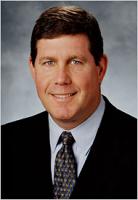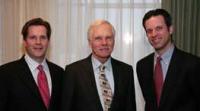
AES , is branching out to wind power generation and other alternative energy. The company which has operations in 26 countries is also interested in entering the 28 billion dollar carbon trading market. Its chief executive, Paul Hanrahan, gave an interview with the new york times about the companies plans.
Also in the news Ted Turner the guy who owns TNT and a whole bunch of other stuff, is starting his own solar business venture with DTSolar.
So what have these tycoons seen that others have not? Simple, renewables are the future, and its going to be much easier to get in on the ground floor than it will be later. No matter how you feel about big business, or the free market system, there is no good reason why you can not make a lot of money and create renewable energy at the same time. In fact the wind and solar industry are the fastest growing sector of the energy market.
 Imagine a carbon regulated world (its coming trust me, and soon.) in which carbon emissions become an added cost. Anyone positioned to supply renewable energy is set to dominate the market. With a large portfolio of renewables you can either offset your emissions and thus avoid added carbon cost, or you can go full renewables and sell your carbon offsets to dirty companies, either way you will be better off than anyone burning old fashion fuels.
Imagine a carbon regulated world (its coming trust me, and soon.) in which carbon emissions become an added cost. Anyone positioned to supply renewable energy is set to dominate the market. With a large portfolio of renewables you can either offset your emissions and thus avoid added carbon cost, or you can go full renewables and sell your carbon offsets to dirty companies, either way you will be better off than anyone burning old fashion fuels.
Companies like Exxon are steadfastly holding to the old school pump and burn model of energy production. They have most likely seen that a coming shortage for (cheap) world oil supplies will only make their current oil stocks more valuable. In fact their future depends on it. It is no secret that Exxon spends millions of dollars each year to maintain the political status-quo in America. They have to, if the political climate were to suddenly shift to a very pro-renewable energy one there is a chance that the shift over to renewables would be so swift that Exxon would be left holding worthless oil that no one wanted.
Renewables are coming and coming fast. If large energy suppliers wish to position themselves to remain dominate in the energy market of tomorrow they are going to need a diverse portfolio of wind, solar, wave, geothermal, and biomass/bio-fuel.
Read the times excerpt from AES and the Turner press release below the fold.
From here
Ted Turner today announced the launch of a new business venture to provide clean power solutions. Turner will partner with Dome-Tech Solar, a leading solar energy developer, based in Branchburg, New Jersey to create DT Solar, a Turner renewable energy company. DT Solar will initially focus on providing on-site solar electric power systems for commercial and industrial clients, as well as developing larger, utility-scale solar power plants in the southwestern United States.
“Our future depends on changing the way we use energy,†said Turner. “We’ve got to move away from fossil fuels and develop long-term energy solutions that work. Using clean energy technologies, such as solar power, is the right thing to do, and it represents a tremendous business opportunity.â€
From here
Q. Last spring, AES announced plans to invest about $1 billion over the next three years in alternative energy projects, specifically wind power generation and biomass. What business factors led to that decision?
A. We had decided that it was time to look at the alternative energy field as an area that was a good fit with our strategy. We saw that alternative energy was attractive from the environmental standpoint and from the energy security standpoint. And it is really the area with the highest growth potential. The wind industry is expected to triple in size by 2015, so it’s going from about 73 gigawatts to over 200 gigawatts.
Q. AES appears to have adopted several strategies in its expansion into wind generation, buying companies outright as well as buying majority interest — does that give you more mobility to get into markets quickly?
A. What it allows us to do is to take advantage of our global footprint. We are in 26 countries, and by buying a company in a region we can take that skill set the company has and expand it globally. A good example is our SeaWest acquisition where we bought a U.S. wind company, and we’re developing U.S. wind projects as well as expanding into countries like Bulgaria, Scotland and France. And we’re looking at new projects in India, China and the Czech Republic.
Q. AES has had record revenue recently — a 14 percent increase to $3.15 billion in the third quarter. Why is that?
A. We are one of the few global power companies that not only is operating in developed countries but also in emerging markets, which, with respect to electricity, have much higher growth rates. We consciously got into this area because there is a high need to get power into these markets for economic growth, and it allows us as a company to grow much faster.
Q. Several years ago, the company’s bottom line was tripped up by foreign currency transaction problems. What have you done to guard against a recurrence?
A. We have dramatically reduced the amount of debt, and in various locations we’ve refinanced dollar debt with local currency debt so we don’t have that same kind of foreign currency exposure.
Q. One of AES’s new ventures is liquefied natural gas terminals. Are the prices for natural gas high enough to justify that kind of investment?
A. We have three terminals in development right now. The U.S. is running out of natural gas — production is declining and demand growing — so the expectation is that the import levels will go from 3 percent today to about 24 percent in 2020. The constraint is, How do you get it into the country? If the three are successful, we will continue to look for opportunities to develop L.N.G. terminals.
Q. Where are those liquid natural gas terminals?
A. The Bahamas, to provide gas to the Florida market, Baltimore and one offshore in Boston.
Q. How do AES’s ventures in alternative energy relate to climate change?
A. We developed it as a way to mitigate carbon emissions from our plants. We started doing this in the early ’90s. For example, for our power plant in Connecticut, we planted 50 million trees in Guatemala. This new effort is a continuation of that theme, but looking at it now not as a social responsibility project but as something that has profit potential given that people are buying these credits in Europe and are likely to continue buying them.
Q. In July, AES announced the installation of clean coal technology at your power plant in Dresden, N.Y. With future oil supplies so problematical, what do you see as coal’s future?
A. For countries with coal as an indigenous resource, coal has a lot of potential because you can do a lot to reduce the particulate emissions and the sulfur nitrogen emissions which cause acid rain. You can reduce the carbon emissions from a power plant very cheaply, so we think there is a lot of potential to produce electricity in an environmentally responsible way.
As a AES employee and working for traditional way of power generation industry, i strongly believe the future is for renewal energy/clean energy buisness and AES has taken a lead to invest on it.We as humman society has to protect our enviroment and limited natural resources for a better use.
I want to be a part of these team who support and advocate for renewal energy production and looks for a job opportunity.
I am sure you will recommend few company,who wants to hire people for these type of buisness development activity.
Hello Sunil.
If you are interested in getting a job in the renewable energy market I would start here.
That should give you a good start.